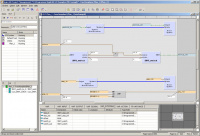General Input and Output Specification of LOYTEC devices
UI – Universal Input
UIs are universal inputs for four different input types. They have an input voltage range of SELV 0 V to 10 V (4-20 mA), and can withstand up to 30 V. The UIs correspond to class 1 with a relative accuracy of ±1 % (of measured value) between 1 V and 10 V, and an absolute accuracy of ±10 mV between 0 V and 1 V. The ADC resolution is 16 bits. Galvanically isolated sensors resp. switches must be connected. Universal inputs can be configured as:
-
Binary Input (Digital Input)
Input impedance > 20 kΩ, sampling period 10 ms.- In voltage mode, the threshold values are < 0.8 V for low level and > 2 V for high level.
- In resistance mode, the threshold values are < 1.9 kΩ for low level and > 6.7 kΩ for high level.
-
Voltage Metering 0-10 V
Input Impedance > 20 kΩ, sampling period < 1 s. -
Current loop 4-20 mA
Input Impedance > 20 kΩ, sampling period < 1 s. An internal shunt of 249 Ω is available for some universal inputs. Otherwise, an external resistor of 249 Ω must be used as a shunt. -
Resistance Measurement
Input Impedance 10 kΩ, sampling period < 1 s. Resistors in the range of 1 kΩ to 100 kΩ can be measured. For popular temperature sensors (e.g. Pt1000, NTC10K, NTC1K8, Ni1000) fixed internal translation tables are provided. For all other temperature sensors, translation tables can be defined in the configuration tool and used on the device.
The average sampling period p of analog inputs depends on the number of active (non-disabled) universal inputs n that are configured in analog mode. The formula for p is:
| p = n * 125 ms |
This means if e.g. only two UIs are configured as analog inputs, a new sample is taken every 250 ms (on average) for each of the two inputs. The UIs configured as digital inputs are unaffected (sampling period always 10 ms) by this formula.
DI – Digital Input, Counter Input (S0-Pulse)
DIs are fast binary inputs, which can also be used as counter inputs (S0). They follow the S0 specification for electric meters and have a sampling rate of 10 ms. They change state at a load of 195 Ω between the DI terminal and GND. Galvanically isolated sensors resp. switches must be connected.The input can withstand up to 30 V SELV.
AO – Analog Output
AOs are analog outputs with a signal range of SELV 0 to 10 V (up to 12 V), a resolution of 10 bits, and a maximum output current of 10 mA, short circuit proof (2 outputs at a time). The accuracy over the whole range is ±100 mV.
DO – Digital Output
The following digital outputs are available:
- Relay 6A Output: Switching capacity 6A, 250 V AC resp. 30 V DC. Max in-rush current 6A, max. 600W (resistive) @ 250 V AC.
- Relay 8A Output: Switching capacity 10A, 250 V AC resp. 30 V DC. Max in-rush current 8A, max. 1600W (resistive) @ 250 V AC.
- Relay 10A Output: Switching capacity 10A, 250 V AC resp. 30 V DC. Max in-rush current 10A, max. 1600W (resistive) @ 250 V AC.
- Relay 16A Output: Switching capacity 16A, 250 V AC. Max in-rush current 80A, max. 2000W (resistive) @ 250 V AC.
- TRIAC Output: Switching capacity 0.5A, 24 to 240 V AC, 50/60 Hz. External relays must not be connected.
When switching higher loads than specified an interface relay must be used and a quenching circuit like a varistor or RC element must be used at the selected LOYTEC device.Outputs must be properly fused according to rated current.
IO – Universal Analog/Digital Input/Output
IOs are universal input/output terminals which can be configured as an input to measure resistance, voltage, or current (with or without internal shunt), or as an output to drive a 0-10 V voltage output.
The universal IOs have an input voltage range of 0 to 10 V, and can withstand up to 30 V. The universal IOs correspond to class 1 with a relative accuracy of ±0.5 % (of measured value) between 1 V and 10 V, and an absolute accuracy of ±5 mV between 0 V and 1 V.
The A DC resolution is 12 bits. Galvanically isolated sensors resp. switches must be connected. The sampling period of IO inputs is 50 ms. This limits Pulse Count inputs to a maximum frequency of 10 Hz.
In output mode, the universal IOs have a signal range from 0 to 10 V, a resolution of 12 bits, and a maximum output current of 25 mA (short circuit proof). The accuracy over the whole range is ±100 mV.
PRESS – Pressure Sensor
These inputs represent differential pressure sensors. They are equipped with two 3/16” (4.8 mm) hose connectors.


